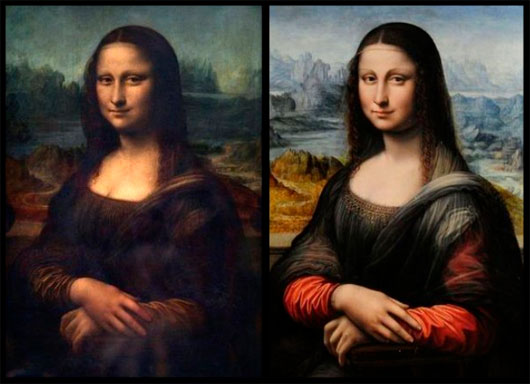Leonard Da Vinci is the world's first 3D artist?
Leonardo da Vinci was a Renaissance master, he was interested in not only art but also anatomy, geology, literature ., and also thought of early hydraulic and airplane systems. . Therefore, it may not be too much to conjecture that he is also the world's first 3D painting artist.
German researchers Claus-Christian Carbon and Vera Hesslinger have commented on the 3D picture mentioned above in their study of his famous portrait of Mona Lisa.
Different views
The duo analyzed the famous version of the painting, also known as La Gioconda, hanging in the Louvre museum in Paris. They also looked at another version called Prado Mona Lisa hanging from the Prado museum in Spain.
Based on that, they concluded that these two works of art, if overlapped, could bring the first 3D image of the world. In other words, Leonardo Da Vinci created the first 3D artwork of mankind.
Carbon and Hesslinger laid the foundation for their hypothesis based on a parallel comparison of the Mona Lisa and the Prado - the artwork introduced to the public in 2012 as a work by Leonardo or by his students. create. They said there was a slight change in perspective between the two works, meaning portraits were drawn from separate observation points.
"When I first mulled over two pictures put together, I realized that there was a slight difference in perspective" - Carbon, a scientist from the University of Hamburg in Germany wrote in an e-mail sent to Live Science - " This is especially evident if you observe the chair La Gioconda sits in. In the Prado version, you can still see the innermost corner of the chair La Gioconda rests on, which is not included in the Louvre version, because the Prado artist looked at the model slightly to the left compared to the artist who drew the Louvre version ".

The Mona Lisa is painted by Leonardo da Vinci (left) and hung at the Prado museum in Madrid
There are 3D image traces
Curious, Carbon and Hesslinger decided to calculate where the artists would have to sit to create each version of the Mona Lisa above. They found that the horizontal difference is about 6.8 cm, which is very close to the average distance between one's eyes.
From here the researchers were inclined to hypothesize that Leonardo Da Vinci was trying to create a 3D work. Naturally, each of our eyes looks at objects from different angles, capturing separate, flat images. It is the brain that combines those flat images together and produces the complete 3D image that we "see" in real life.
Based on this fact, Carbon and Hesslinger conjecture that two different views are used to create Mona Lisa in the Louvre and Prado belongs to a complete 3-dimensional image. They believe that overlapping two pictures together, we will have a primitive 3D masterpiece.
2 people have used red 3-dimensional image technology - cyan to combine 2 portraits. As a result, the researchers found that there were places to show protrusions like in 3D images in the hand area. They just don't know if this is an accidental, random coincidence effect, or Leonardo Da Vinci intentionally created them, in an attempt to draw the first 3D picture.
Carbon pointed out that Leonardo Da Vinci had "active" optical research and 3-dimensional images. "But despite many signs, we still have no evidence to support our hypothesis" - he said.
The scientific world is suspicious
Other scientists also doubt the judgment of two people. Researcher Martin Arguin of the University of Montreal wrote to Live Science and stated his opposition view. He pointed out that the big difference in many parts of the two pictures makes the hypothesis that they were born in a 3D work of art unreasonable. According to him, the difference is clearly shown vertically, instead of horizontal, which is essential to creating three-dimensional images.
"Leonardo DaVinci wrote about the image captured by 1 eye and 2 eyes, as well as studying various aspects of optics such as eye anatomy, light reflection . He even experimented with the light sources have been changed in color " - Science News editor Erika Engelhaupt commented - " I wonder if you have gathered your knowledge to understand how to create a 3D image. But the paintings don't seem to be the perfect combination to create 3-dimensional images. "
- Revealing the portrait of Leonardo da Vinci through an ancient 500-year-old painting
- The construction of a 'mechanical lion' by Leonardo da Vinci
- Discovered the painting that shocked Da Vinci's art world
- Disgusting illness caused the artist Leonardo da Vinci to stop painting
- Find the lost masterpiece of Leonardo da Vinci?
- Leonardo da Vinci 'religion' buddy paintings?
- Decode the message hidden behind Leonardo da Vinci's Last Dinner
- The timeless designs of Leonardo da Vinci
- After nearly 500 years, scientists have discovered the secret hidden under Leonardo da Vinci's painting
- Find the descendant of Monalisa
- Where is Leonardo da Vinci painting the Mona Lisa?
- Creative funny picture with Fun Photor 3.8
 'Fine laughs' - Scary and painful torture in ancient times
'Fine laughs' - Scary and painful torture in ancient times The sequence of numbers 142857 of the Egyptian pyramids is known as the strangest number in the world - Why?
The sequence of numbers 142857 of the Egyptian pyramids is known as the strangest number in the world - Why? History of the iron
History of the iron What is alum?
What is alum?